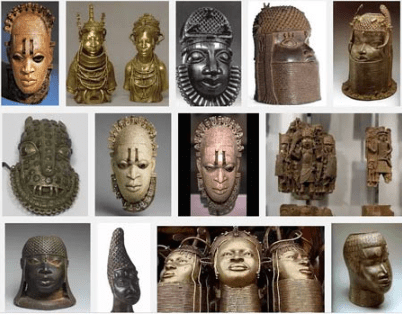
Top 15 Historical Artifacts in Nigeria
Top 15 Historical Artifacts in Nigeria: Nigeria, a country with a rich cultural heritage and a long history, boasts a plethora of historical artifacts that offer insights into its past civilizations and artistic achievements. These artifacts provide a glimpse into the diverse cultural tapestry of Nigeria, spanning centuries of history. From ancient sculptures to intricate bronzes and ceremonial masks, Nigeria’s historical artifacts offer a window into the country’s artistic traditions, religious practices, and social structures. This article aims to delve into the top 15 historical artifacts in Nigeria, shedding light on their significance, cultural context, and contribution to Nigeria’s heritage.Top 15 Historical Artifacts in Nigeria
Read Also: Top 15 Influencer Dancers in Nigeria
👉 Relocate to Canada Today!
Live, Study and Work in Canada. No Payment is Required! Hurry Now click here to Apply >> Immigrate to CanadaTop Historical Artifacts in Nigeria
1. Nok Terracotta Figures:
The Nok Terracotta Figures, dating back to 500 BCE to 200 CE, are among the oldest known sculptures in sub-Saharan Africa. These clay figures were discovered in the Nok region of central Nigeria and represent human figures with elaborate hairstyles, jewelry, and intricate facial features. The Nok Terracotta Figures provide valuable insights into early Nigerian artistry and cultural practices.
2. Ife Bronze Heads:
The Ife Bronze Heads are iconic representations of the artistic excellence of the ancient Ife kingdom, dating back to the 12th to 15th centuries CE. These life-size bronze sculptures depict the heads of significant individuals, showcasing the exceptional craftsmanship and attention to detail of the Ife artisans. The Ife Bronze Heads symbolize the artistic and cultural sophistication of ancient Nigeria.Romantic Love Messages
3. Benin Bronzes:
The Benin Bronzes are a collection of exquisite brass sculptures and plaques that originated from the ancient Kingdom of Benin (now part of modern-day Nigeria). Created during the 13th to 15th centuries CE, these bronzes depict royal figures, warriors, and various scenes from court life. The Benin Bronzes are remarkable examples of the artistic prowess and historical narratives of the Benin Kingdom.
4. Igbo-Ukwu Artifacts:
The Igbo-Ukwu Artifacts, discovered in southeastern Nigeria, reveal the ancient Igbo civilization’s advanced metallurgical skills and artistic traditions. Dating back to the 9th century CE, these artifacts include intricately designed bronze ceremonial vessels, jewelry, and other metal objects. The Igbo-Ukwu Artifacts highlight the Igbo people’s cultural and technological achievements during that era.Good Morning Love Message
Read Also: Top 15 Scar Removal Creams Dermatologist
5. Esie Soapstone Figures:
The Esie Soapstone Figures are a collection of stone sculptures found in Esie, Kwara State, Nigeria. These sculptures, estimated to date back to the 12th century CE, depict human figures engaged in various activities, such as hunting, farming, and dancing. The Esie Soapstone Figures are considered the largest collection of stone sculptures in sub-Saharan Africa, providing valuable insights into Nigeria’s precolonial history.
6. Ife Terracotta Heads:
Similar to the Ife Bronze Heads, the Ife Terracotta Heads showcase the artistic brilliance of the ancient Ife civilization. These terracotta sculptures, dating back to the 12th to 15th centuries CE, depict human heads with intricate facial features, unique hairstyles, and elaborate headdresses. The Ife Terracotta Heads exemplify the mastery of sculptural techniques and the cultural significance of portraiture in Ife society.
7. Tsoede Brass Bell:
The Tsoede Brass Bell, also known as the “Ogboni Bell,” is a significant artifact from the ancient Oyo Empire. The bell, crafted from brass, bears intricate engravings and symbols that represent the power and authority of the Oyo rulers. The Tsoede Brass Bell serves as a symbol of leadership and spiritual significance in Yoruba culture.
👉 Relocate to Canada Today!
Live, Study and Work in Canada. No Payment is Required! Hurry Now click here to Apply >> Immigrate to CanadaRead Also: Top 15 Cocoa Butter Lotion for Dark Skin in Nigeria
8. Owo Wooden Carvings:
The Owo Wooden Carvings are intricate and ornate sculptures created by the Owo people of southwestern Nigeria. These wooden carvings, dating back to the 15th to 17th centuries CE, depict various human figures, animals, and mythical creatures. The Owo Wooden Carvings are renowned for their detailed craftsmanship and cultural symbolism, reflecting the Owo people’s social hierarchy and religious beliefs.
9. Gidan Dan Hausa:
Gidan Dan Hausa, meaning “The House of the Hausa,” is a historical building located in Kano, Nigeria. Built in the late 15th century, Gidan Dan Hausa served as the residence of the powerful Kano Emirs. The architecture of the building exemplifies traditional Hausa construction techniques, featuring intricate carvings, decorative motifs, and a courtyard layout. Gidan Dan Hausa stands as a testament to the historical and architectural heritage of northern Nigeria.
10. Ikom Monoliths:
The Ikom Monoliths are a collection of large stone sculptures found in Cross River State, Nigeria. Dating back to the 4th to 18th centuries CE, these monoliths feature abstract and geometric designs, often depicting human figures and animals. The Ikom Monoliths serve as markers of cultural and religious significance, representing ancestral spirits and important communal events.Information Guide Nigeria
11. Uli Body Art:
Uli Body Art is a traditional form of body painting practiced by the Igbo women of southeastern Nigeria. Using natural pigments, the women create intricate patterns and designs on their bodies, reflecting cultural symbols, identity, and aesthetics. Uli Body Art is not only a visual art form but also serves as a means of communication and cultural expression within Igbo society.
12. Gwari Pottery:
Gwari Pottery is a traditional pottery style practiced by the Gwari people in central Nigeria. The Gwari potters use local clay to create functional vessels, such as cooking pots, water jars, and storage containers. The pottery is characterized by its distinctive designs, including geometric patterns and incised decorations. Gwari Pottery reflects the cultural traditions and daily life of the Gwari community.
Read Also: Top 15 Shea Butter Lotion For Dark Skin in Nigeria
13. Hausa Embroidery:
Hausa Embroidery is a traditional craft practiced by the Hausa people of northern Nigeria. Intricate patterns and designs are hand-stitched onto fabrics, creating colorful and vibrant textiles. Hausa embroidery often features geometric motifs, floral patterns, and calligraphy. This craft represents the artistic skills and cultural heritage of the Hausa community.Girona strengthen attack with Brazilian starlet arriving on loan
14. Ekpe Masks:
Ekpe Masks, also known as Ekoi Masks, are ceremonial masks used by the Ekpe secret societies in southeastern Nigeria. These masks are carved from wood and adorned with intricate details and vibrant colors. Ekpe Masks are worn during rituals, dances, and ceremonies, representing ancestral spirits and conveying social messages within the community.NYSC Portal
15. Sokoto Caliphate Manuscripts:
The Sokoto Caliphate Manuscripts are a collection of Islamic texts and documents produced during the 19th century in the Sokoto Caliphate, led by Usman dan Fodio. These manuscripts, written in Arabic and local languages, cover various subjects such as theology, jurisprudence, history, and literature. The Sokoto Caliphate Manuscripts are valuable sources of knowledge, providing insights into Islamic scholarship and intellectual pursuits in Nigeria.
Read Also: Top 15 E-Wallets Compatible with Major Banks in Nigeria
Conclusion
Nigeria’s historical artifacts are a testament to the country’s rich cultural heritage, artistic achievements, and diverse civilizations. The top 15 artifacts mentioned in this article, including the Nok Terracotta Figures, Ife Bronze Heads, Benin Bronzes, Igbo-Ukwu Artifacts, Esie Soapstone Figures, Ife Terracotta Heads, Tsoede Brass Bell, Owo Wooden Carvings, Gidan Dan Hausa, Ikom Monoliths, Uli Body Art, Gwari Pottery, Hausa Embroidery, Ekpe Masks, and Sokoto Caliphate Manuscripts, represent different periods, regions, and cultural practices within Nigeria.
These artifacts provide invaluable insights into Nigeria’s history, cultural traditions, artistic expressions, and societal structures. They serve as a link to the past, reminding us of the diverse civilizations, skilled craftsmanship, and cultural legacies that have shaped Nigeria over the centuries.JAMB Portal
Preserving and appreciating these historical artifacts is essential for Nigeria’s cultural identity, heritage tourism, and academic research. They not only enrich our understanding of Nigeria’s past but also contribute to the country’s contemporary artistic and cultural landscape.Tottenham chief Daniel Levy meets with Bayern Munich
It is crucial to protect and preserve these artifacts through proper conservation efforts, legal frameworks, and cultural education. By recognizing the significance of these historical artifacts, Nigeria can continue to celebrate its rich heritage and ensure that future generations appreciate and learn from these tangible treasures.
Check JAMB RESULT
Check and Confirm: How much is Dollar to Naira






